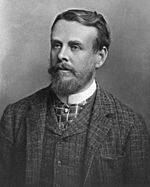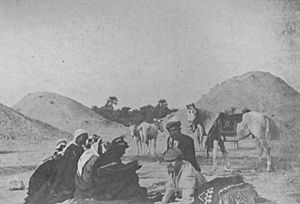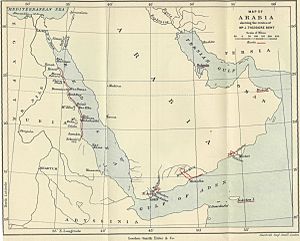James Theodore Bent facts for kids
Quick facts for kids
James Theodore Bent
|
|
|---|---|

James Theodore Bent
|
|
| Born | 30 March 1852 Liverpool, Merseyside, England
|
| Died | 5 May 1897 (aged 45) London, England
|
| Nationality | English |
James Theodore Bent (born March 30, 1852 – died May 5, 1897) was an English explorer, archaeologist, and author. He traveled to many parts of the world, especially the Middle East and Africa, to study ancient cultures and discover old ruins. His wife, Mabel Bent, often joined him on these exciting journeys.
Biography
James Theodore Bent was born in Liverpool, England, in 1852. He grew up in Yorkshire and went to good schools, including Repton School and Wadham College, Oxford. After finishing his studies in 1875, he started his travels.
In 1877, James married Mabel Hall-Dare. Mabel became his constant travel partner, taking photos and keeping diaries of their adventures. They traveled abroad every year, exploring places like Italy and Greece.
Bent wrote several books about his early travels. He published a book about the small country of San Marino in 1879 and was even made a citizen there! He also wrote about the history of Genoa and a book about the Italian hero Giuseppe Garibaldi. Later, he explored the Aegean islands and wrote The Cyclades in 1885, sharing stories about life among the islanders.
Archaeological Discoveries

After his early travels, Bent focused more on archaeology, which is the study of human history through digging up old sites. From 1883 to 1888, he explored the Eastern Mediterranean and Anatolia. He shared his findings in academic journals. His work on the Greek island of Antiparos was particularly important.
In 1889, Bent began digging in the Bahrain Islands in the Persian Gulf. He was looking for clues that this area might have been an early home for the Phoenician civilization. After this trip, he and Mabel traveled through Persia (modern-day Iran) and even met the Shah, Naser al-Din Shah Qajar.
In 1891, Bent traveled to South Africa with his wife and a surveyor named Robert McNair Wilson Swan. They wanted to understand the origin of ancient ruins in Mashonaland. They made the first detailed study of the famous Great Zimbabwe ruins. Bent wrote about this work in his book The Ruined Cities of Mashonaland (1892).
In 1893, he investigated the ruins of Axum and other sites in northern Ethiopia. He described this expedition in his book The Sacred City of the Ethiopians (1893).
Bent then explored the challenging Hadramut region in southern Arabia from 1893 to 1894. He studied the area's ancient history and geography. On the Dhofar coast in 1894-1895, he found ruins he believed were connected to ancient frankincense traders. In 1895-1896, he explored the African coast of the Red Sea, finding old gold mines and signs of ancient Sabean influence.
While on another journey in South Arabia and Socotra in 1896-1897, Bent became very ill with a serious fever. He died in London on May 5, 1897, just a few days after returning home.
Mabel Bent, who helped her husband greatly with her photography and other skills, published a book in 1900 called Southern Arabia, Soudan and Sakotra. This book shared the results of their last expedition.
Legacy
James Theodore Bent is remembered in the scientific name of a type of Arabian lizard, Uromastyx benti.


